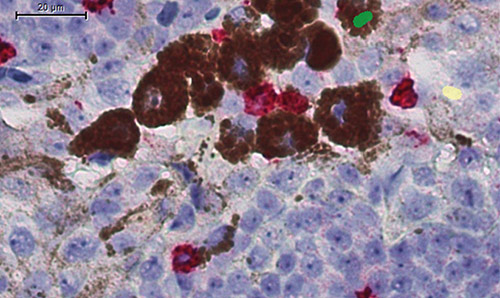Cancers develop shrewd survival mechanisms that often defeat therapeutic strategies that aim to reverse their acquired resistance to treatment. New research shows blocking genomic instability in an aggressive form of cancer—metastatic cutaneous melanoma—may prevent tumors from acquiring genetic diversity that enables them to escape therapy.
The findings, published in the journal Cancer Discovery on January 26 “Blocking Genomic Instability Prevents Acquired Resistance to MAPK Inhibitor Therapy in Melanoma,” may open new avenues for treating currently treatment-resistant forms of melanoma.
“We are taking a fresh approach to combat ‘acquired therapy resistance’—the ability of cancers to escape targeted treatments by undergoing molecular evolution. Intensive research has focused on treatment of cancers that have relapsed, seeking to intervene after the tumor cells have become more complicated and stronger. We thought that preventing, rather than trying to reverse resistance after the cancer has become more aggressive, may improve our patients’ odds of survival,” said Roger Lo, MD, PhD, a researcher and professor of medicine and molecular and medical pharmacology at the David Geffen School of Medicine at UCLA and co-senior author of the study.
Patients with metastatic cutaneous melanoma are treated with MAPK inhibitors (MAPKi) and may develop resistance to therapy soon afterwards. The roots of resistance to treatment lie in the ability of the melanoma to evolve extrachromosomal circular DNA (ecDNA) and complex genomic rearrangements (CGRs). The resulting genetic diversity confers the ability to escape therapy on the melanomas.
“We hope that by blocking the means for melanoma to generate genetic diversity, we may prevent the myriad of ways the cancer escapes targeted therapy,” said Lo.
Analyzing tumor biopsies from patients taken before MAPKi therapy and during clinical recurrence, the researchers found that the melanoma genome undergoes extensive ‘shattering and re-stitching’ in response to the therapy—a process called chromothripsis, where small amounts of chromosomal DNA drop out of the chromosome and are re-stitched to become circular extrachromosomal DNAs (ecDNAs). They found cancer cells can generate and retain up to 100 copies of ecDNA. These amplify key genes that drive resistance to treatment. The ecDNAs may also reintegrate into chromosomes generating complex genomic rearrangements (CGRs) and providing a stable source of gene amplification.
“We analyzed how the re-stitching of shattered genomic DNA occurred in resistant melanoma and discovered that a protein called DNA-PK may be particularly important,” said Prashanthi Dharanipragada, PhD, a post-doctoral fellow on the Lo team and a co-lead author with post-doctoral fellow Xiao Zhang, PhD.
“We tested a new combination approach to block genomic instability and prevent acquired resistance in model cell lines and patients’ tumor cells implanted in mice,” said Gatien Moriceau, PhD, assistant adjunct professor of medicine and co-senior author. “It may be possible to apply this approach to multiple subtypes of melanoma and several other types of aggressive cancers such as pancreatic and lung cancers.”
Lo and co-author Stergios Moschos, MD, PhD, a clinical professor and melanoma researcher at the University of North Carolina at Chapel Hill, are designing a clinical trial for patients with subtypes of melanoma based on the findings reported in this study.


